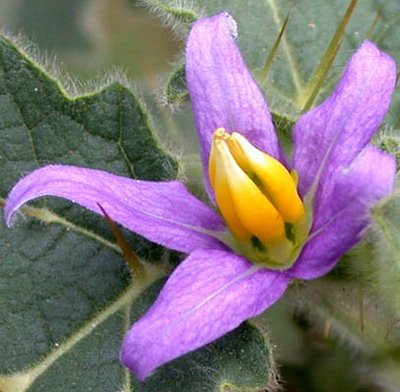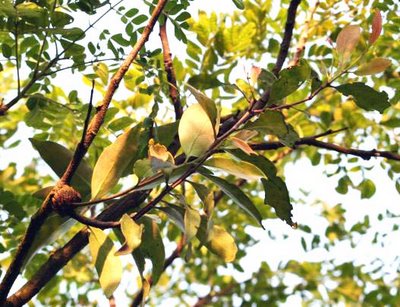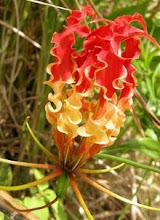 I do not expect this "all male- flowers only " papaya 'tree' to bear any fruit. But lately I spotted a 4 inch+ long fruit dangling at the end. To read more on this phenomena follow the link here
I do not expect this "all male- flowers only " papaya 'tree' to bear any fruit. But lately I spotted a 4 inch+ long fruit dangling at the end. To read more on this phenomena follow the link here
Friday, March 24, 2006
Papaya fruit at end of a foot- long stalk
 I do not expect this "all male- flowers only " papaya 'tree' to bear any fruit. But lately I spotted a 4 inch+ long fruit dangling at the end. To read more on this phenomena follow the link here
I do not expect this "all male- flowers only " papaya 'tree' to bear any fruit. But lately I spotted a 4 inch+ long fruit dangling at the end. To read more on this phenomena follow the link here
Sunday, March 19, 2006
Tree Top Walk Revisited

Rubber Hevea brasiliensis trilobed fruits and inflorescence
It was a 8:45 Sunday morning and I found myself in Venus Drive. My two collegues have not arrived yet. So I meandered to a field nearby. The fallen white 5-star petals one large Pong Pong tree traced a circular 'drop- zone' under the foliage. Then I saw a pair of Collared Kingfishers. After a few attempts ( they saw me) I managed to frame one sitting on a high branch. Then closeby another high branch with fruits that looked like rubber seed. This was my 3rd visit to the TTW (Tree Top Walk) and I hoped to see something different ( read my 05' posting of TTW plants here).

Collared Kingfisher
We followed others and took the 'new' path to TTW from Venus Drive CP. On the way we saw a ball of mud the size of a small coconut ( ~ 3-4" in diameter). It turned out to be ant's nest ( see image below) instead of the more dangerous wasps.
 I was hoping I could revisit those plants I saw last year. But I did not find most of thems. The monkeys, squirrels were there. I spotted the familiar climber Bauhinia sembifida near the entrance. I missed the Myrmeconauclea strigosa ant-plant and the Baccaurea parviflora on the plank walk back after the TTW.
I was hoping I could revisit those plants I saw last year. But I did not find most of thems. The monkeys, squirrels were there. I spotted the familiar climber Bauhinia sembifida near the entrance. I missed the Myrmeconauclea strigosa ant-plant and the Baccaurea parviflora on the plank walk back after the TTW.
 I was hoping I could revisit those plants I saw last year. But I did not find most of thems. The monkeys, squirrels were there. I spotted the familiar climber Bauhinia sembifida near the entrance. I missed the Myrmeconauclea strigosa ant-plant and the Baccaurea parviflora on the plank walk back after the TTW.
I was hoping I could revisit those plants I saw last year. But I did not find most of thems. The monkeys, squirrels were there. I spotted the familiar climber Bauhinia sembifida near the entrance. I missed the Myrmeconauclea strigosa ant-plant and the Baccaurea parviflora on the plank walk back after the TTW. Red bracteoles on inflorescence of Macaranga heynei
Red bracteoles on inflorescence of Macaranga heynei Witches Broom in the making -adnormal growth caused by viral attack of the plant. Most of the brooms ( black mass of dead branches seen in '05 May ) were gone - perhaps someone had trimmed them.
Witches Broom in the making -adnormal growth caused by viral attack of the plant. Most of the brooms ( black mass of dead branches seen in '05 May ) were gone - perhaps someone had trimmed them.Saturday, March 18, 2006
One Saturday Morning
One Saturday I brought my digi camera to a Marsiling neighbourhood. I spotted the lone Chinese New Year nipple fruit plant a week ago and today I decided to check it out. It was a hot and clear day.... This plant exudes a pleasant sweet fragrant aroma.
 Nipple fruit Solanum mammosum
Nipple fruit Solanum mammosum
flowers (top) and the yellow fruit (below).

 Nipple fruit Solanum mammosum
Nipple fruit Solanum mammosumflowers (top) and the yellow fruit (below).

Egg plants from my child-hood encounter also have similar but much shorter and curved dark brown spines. Look at those leaves with spear-like thorns!


At 'grass-root' level - even the humble weeds are in their splendor - Cupid's shaving brush Emilia sonchchifolia ready to release their ball heads - laden with silky white hairs.
 And a nearby Golden Shower Cassia fistula tree littered the ground with golden yellow petals and the 'C'-shaped or semi-circular stamens that stained the pavement ( see image below)
And a nearby Golden Shower Cassia fistula tree littered the ground with golden yellow petals and the 'C'-shaped or semi-circular stamens that stained the pavement ( see image below)
The hot dry weather in early March had triggered quite a number of pink mempat Cratoxylum formosum to shed their leaves and flowers thus exposing the parasite plants that live off them ( see the tell-tale sign of their presence in the image below).
 And a nearby Golden Shower Cassia fistula tree littered the ground with golden yellow petals and the 'C'-shaped or semi-circular stamens that stained the pavement ( see image below)
And a nearby Golden Shower Cassia fistula tree littered the ground with golden yellow petals and the 'C'-shaped or semi-circular stamens that stained the pavement ( see image below)
The hot dry weather in early March had triggered quite a number of pink mempat Cratoxylum formosum to shed their leaves and flowers thus exposing the parasite plants that live off them ( see the tell-tale sign of their presence in the image below).

Friday, March 17, 2006
Mistletoe flowering on a branch of old rain tree
 A typical young branch of a dendrophthoe pentandra
A typical young branch of a dendrophthoe pentandra- note the bulbous attachement point to host branch.

Dendrophthoe pentandra flowering
The contrasting differences in leaf/branch form
and the bulbous attachement "betray" their presence as
parasitic plants living off the host.
The contrasting differences in leaf/branch form
and the bulbous attachement "betray" their presence as
parasitic plants living off the host.
Subscribe to:
Comments (Atom)


